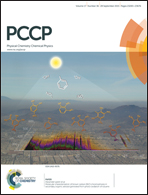Chirality control of nonplanar lead phthalocyanine (PbPc) and its potential application in high-density storage: a theoretical investigation†
Abstract
On single-crystal surfaces, achiral molecules may become chiral owing to confinement in two dimensions (2D). Metal phthalocyanines (MPcs) on Cu(001) and Ag(100) surfaces have exhibited a chiral electronic state. However, the chirality is not always desirable since crystal defects (grain boundaries) inevitably occur between two different chiral domains during the self-assembly of single layers. In this theoretical study, we propose to utilize metal(001) substrates with different electron configurations to mediate the azimuthal orientations of nonplanar PbPc. The results show that PbPc is chiral on Cu(001) with a partially filled s orbital (3d104s1) but achiral on Pd(001) with a completely filled d orbital (4d10). The mechanism that PbPc prefers achiral azimuthal orientation rather than chiral orientation on Pd(001) is clarified. In addition, we predict that PbPc can form a (3 × 4) surface reconstruction. While it is used for data storage, the capacity is almost three orders of magnitude higher than the present storage materials.


 Please wait while we load your content...
Please wait while we load your content...